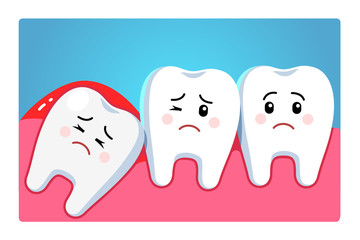
Wisdom teeth removal is the removal of the last of our molars to erupt between the ages of 17 and 25. Wisdom teeth can often cause issues if they don’t fully erupt or grow in incorrectly; this often requires removal. Understanding why you may need your wisdom teeth removed and what happens during the procedure can help alleviate any worries or distress associated with extracting those pesky little buggers.
We have also included some helpful post-surgery recovery tips that will make bouncing back from surgery easier! Read on to learn everything you need to know about having your wisdom teeth removed.
Overview of Wisdom Teeth Removal
Wisdom teeth removal (also known as third molar extraction) is a procedure to remove one or more of the four third molars that grow in the back portion of your mouth. This dental treatment, although popular, may be considered fairly invasive. The wisdom teeth are often called “third molars” because they usually appear at the back of your mouth, behind your second set of permanent molars, and are the last adult teeth to erupt.
In many cases, people’s mouths are too small for their wisdom teeth and must be removed. Even when there is enough space for them, other problems can occur, such as impacted wisdom teeth (where the tooth cannot fully emerge from the gums), decay, gum disease, or crowding other teeth. Wisdom tooth removal is one of the most common dental procedures and can help prevent many potential oral health issues.
Reasons for Wisdom Teeth Removal
Wisdom teeth are often removed if:
They cause pain in the gums or jaw due to impaction
Lead to overcrowding of other teeth
Cause infection, decay, or gum disease
Make it difficult to properly clean the area around them, leading to an increased risk of infection or decay
They result in overcrowding that causes adjacent teeth to become misaligned (orthodontic problem)
They are causing damage to existing teeth or other structures within the mouth
They are impacted and have only partially emerged, making them difficult to clean and prone to infection
Wisdom Teeth Removal and its Process
Preparing and Getting Ready for the Procedure
Before the procedure, your dentist will take an X-ray of your mouth to assess the position and size of your wisdom teeth accurately. In some cases, a CT scan may be recommended instead to get a more detailed picture of the area. Your dentist will then discuss what types of anesthesia would be best suited for you depending on the complexity of your procedure and any underlying medical conditions or allergies you may have.
Types of Anesthesia Used During the Procedure
The type of anesthesia used for wisdom teeth removal depends on the extent of the surgery and whether or not you are having all four removed at once. Local anesthetic is typically used to numb the area around your mouth and jaw. At the same time, general anesthesia may be recommended if you have multiple teeth extracted or if there is a greater risk of complications due to existing medical conditions.
Steps Involved in the Surgery
Incision: Your dentist will make an incision into your gums to expose the tooth that needs removal. This can be done with a scalpel or laser, depending on your procedure’s complexity.
Dissection: Once the tooth has been exposed, it must be carefully separated from the surrounding tissue and bone.
Extraction: The tooth is then gently removed from its socket using forceps, taking care not to damage any other teeth or structures in the area.
Sutures: Once the tooth has been successfully extracted, your dentist will close any incisions made with sutures.
Wisdom Teeth Recovery Tips
A. Pain Management During Recovery
It’s normal to experience pain and discomfort following wisdom teeth removal as your mouth heals. To help manage this pain, your dentist may suggest taking over-the-counter medication such as ibuprofen or acetaminophen for a few days following your procedure and applying an ice pack outside your mouth for 20 minutes at a time.
B. Diet Tips to Help Heal Faster
Maintaining a soft diet while healing from wisdom teeth removal is important. Eating foods that are easy to chew and swallow, such as soups, smoothies, mashed potatoes, and applesauce, can help reduce discomfort and promote healing. Avoiding hard or crunchy foods and sticky substances like caramel or chewing gum is also important to prevent the sutures from coming undone prematurely.
C. Oral Hygiene After Removal
Following wisdom teeth removal, good oral hygiene is essential to avoid infection and promote faster healing. Proper brushing and flossing regularly after meals should be done with extra care to avoid irritating the gums or sutures. Your dentist may also prescribe a special mouthwash to help keep the area clean and prevent infection.
D. Other Post-Surgery Care Instructions
Get plenty of rest following your procedure and take time off from work if necessary
Avoid strenuous activities such as exercise, sports, or any activity that requires you to open your mouth wide
Avoid using straws as this can cause suction in the mouth, which can lead to complications such as dry sockets
Rinse with salt water twice a day for the first week after the surgery
Conclusion
Wisdom teeth removal can be difficult, but post-surgery steps are critical in ensuring a safe and healthy recovery. While it can take weeks or months to recover fully, taking the proper precautions with dietary adjustments, medication, hygiene practices, and home safety will speed up the healing process. Depending on the severity of the case, taking additional aftercare measures like eating soft foods and wearing protective mouthgaurds during sleep may help soothe discomfort and reduce inflammation.
As with any medical issue, it is best to schedule an appointment with your dentist for an examination and pursue treatment such as wisdom teeth removal if needed. Dentists in Canoga Park are experienced in providing comprehensive dental treatment and can help guide you through this important step in your dental health journey.

